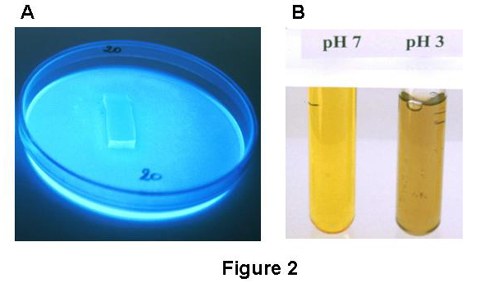Context
This project has the same basic context as the project "Better knowledge of bacterial diseases and of the sensibilities of varieties with the aim of a reasoned fight in fruit horticulture", also exposed on this web site. The pathogenic bacteria encountered in the Walloon region (South of Belgium) raise problem as regards their identification and the way of fighting them. Correct, precise and fast diagnoses of the bacterial diseases and the development of new methods of disease control, alternate to the use of copper salts, would be a pledge of efficiency and of quality for the Walloon agriculture.The study of the secondary metabolites produced by the pathogenic bacteria helps at both levels. A secondary metabolite is a molecule that is not indispensable to the survival of an organism but that is nevertheless produced by this organism. The preservation of the sometimes very complex molecular mechanisms that lead to their production lets suppose the interest of these molecules for the producing bacterial strains.
Concerning the problem of the identification of the pathogenic bacteria, an identification done by using the traditional methods is often time consuming. Pathogenicity tests can be used, but they are difficult to carry out in a systematic way. The search for rapid methods of identification, via the detection by immunological or genetic tests of characters specific to the pathogens, is therefore justified. Among the useful specific characters, the relative specificity of the production of some secondary metabolites renders them useful in order to typify, identify or classify bacteria. Secondary metabolites that are particularly interesting because of the evident adaptive advantages that they confer to the producing strains are phytotoxins, which are virulence factors, and the siderophores, necessary for the fixation of iron.
As regards the problem of disease control, possible alternate methods of disease control are the biological control or the improvement of the resistance of varieties. But these are complex matters. Both require beforehand a good knowledge of the internal variability’s within the species in order to develop methods of disease control that will have a chance to be effective against the biggest number of harmful organisms. It is thus important to have a good knowledge of the ecology of the strains and of their possible adaptive advantages, one with regard to another and with regard to the rest of the microflora colonizing the surface of vegetables. Thus, it seems interesting to characterize strains as regards the secondary metabolites that they are able to produce if we want to know the adaptive advantages of these strains.
Objectives
Study the secondary metabolites having an adaptive interest that are produced by the pathogenic bacteria, and determine their specificities of production. This is done with the aim of a better characterization of the strains (for the later research for new methods of disease control) and of the development of new techniques of identification.Results obtained
The production of toxic lipodepsipeptides produced by the pathovars syringae, aptata and atrofaciens within the species Pseudomonas syringae was studied. These works led to the development of identification tests based on the detection of the biological effects of the produced toxins (Fig. 1A), or on the detection by a polymerase chain reaction (PCR) test of a gene involved in the secretion of these wide spectrum toxins (Fig. 1B).Figure 1
Analyses done in our laboratory indicated that the fluorescent pyoverdine produced by Pseudomonas syringae (Fig. 2A) is atypical. Indeed, bound to the iron, its visual and absorption characteristics vary with the pH (Fig. 2B).
An analysis by High Performance Liquid Chromatography (HPLC) of the pyoverdins produced by various phytopathogenic fluorescent Pseudomonas species was carried out. This study showed the interest of pyoverdins in identification, but also in systematics. New pyoverdins and dihydropyoverdin were purified and characterized by analyses of amino acids and by mass spectrometry. The study demonstrated the conservation of the same atypical pyoverdin in more than 40 pathovars of Pseudomonas syringae and in the very closely related species Pseudomonas viridiflava and Pseudomonas ficuserectae. The closely related species Pseudomonas chicorii produces a very similar but different atypical pyoverdin. The more distant species Pseudomonas asplenii and Pseudomonas fuscovaginae both produce another atypical pyoverdin, the common structure of which is this time more different from that of Pseudomonas syringae. All the more distantly related phytopathogenic fluorescent Pseudomonas species, of which Pseudomonas marginalis, and the saprophytic fluorescent Pseudomonas species produce, on the other hand, typical pyoverdins. Based on these observations, identification tests were developed, either visual (Fig. 2B), by spectrophotometry, by isoelectric focussing or by HPLC.
Yersiniabactin is a siderophore produced by several human-pathogenic enterobacteria, including Yersinia pestis, the causal agent of the bubonic plague. Yersiniabactin production by certain pathovars of Pseudomonas syringae has recently been demonstrated in our laboratory.
Partners
Professeur H. Budzikiewicz et Dr. M. Schäfer, Institut de Chimie Organique, Université de Cologne, AllemagneProfesseur E. de Hoffmann, Laboratoire de Spectrométrie de Masse, Université catholique de Louvain, Louvain-la-Neuve
Professeur H. Maraite, Unité de Phytopathologie, Université catholique de Louvain, Louvain-la-Neuve
Professeur B. Wathelet, Unité de Chimie Biologique et Industrielle, Faculté Universitaire des Sciences Agronomiques de Gembloux
Funding
- DGARNE





